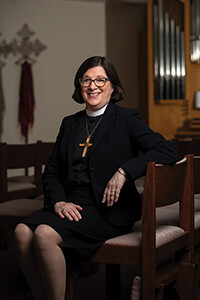What masks do we all wear?
January 7, 2022
Getting ready to leave the house—for work or errands—takes a couple extra steps during a pandemic. Do I know how crowded my destination will be? Did I remember to take a mask? Of all the annoying things about this pandemic, I find remembering to take and to wear a mask is one of the most irksome. Masks aren’t comfortable, they make it more difficult to understand conversations, and they are a daily reminder that we are not out of the woods yet.
Let me be clear—masks are an effective way to stop the spread of this terrible virus, and I will wear one for as long as it takes. I urge all of us to do the same. This isn’t about personal choice, but it is a physical manifestation that in baptism “we, who are many, are one body in Christ, and individually we are members one of another” (Romans 12:5). Wearing a mask is as much for our protection as it is for protecting others. I will continue to mask up.
I always thought it was silly that bandits and robbers are depicted wearing only a mask from just below the eyes down. How could that possibly be a disguise? One’s eyes, hair and ears are all visible. You can hear the voice. You can figure out a person’s stature. What’s the point?
It turns out that sighted people get an enormous number of nonverbal cues from someone’s face. Infants can read faces even before their eyesight is fully developed. An amazing amount of communication is possible even when interacting with someone who speaks a different language.
I don’t think I’m unique in this, but I mentally fill in what a person looks like behind the mask. I make determinations about a person’s age and disposition, not to mention physical characteristics. When I do see someone’s unmasked face, it turns out that I am always wrong. This could be as benign as not imagining a person had a moustache to more significant assumptions about the person’s character.
I mask people even when they aren’t wearing an actual mask.
I mask people even when they aren’t wearing an actual mask. This person is white, or this person is young, or this person is Black, or this person is Asian/Pacific Islander, or this person is Arab/Middle Eastern, or this person is Latinx, or this person is old, or this person is a farmer, or this person is urban, or this person is Lutheran. You can fill out the list. I ascribe characteristics to all of these people without really seeing them.
And then, I wonder about the masks I wear. Wife, daughter, mother, sister. Pastor, friend, the PRESIDING BISHOP (yikes!). When interactions are fraught, the staff have identified what they call my “Queen Face.”
What masks do we all wear? Some are appropriate—we don’t have to emote all over everyone all the time. It’s good to have boundaries—some are needed for safety. But none of these is who we truly are, and all of these take energy.
As we have been returning to in-person worship and once again celebrating communion, I’ve witnessed a beautiful phenomenon. When people come forward to receive the host, they momentarily remove their masks. One by one, in the face of our Lord’s body, they reveal themselves and are revealed. Their faces appear. No mask. No covering. No defense. No need for defense. For that instant they no longer carry the burden of wearing the mask of their demographic, heritage or ethnicity. They are no longer called upon to be stoic.
At that moment they realize on earth what we shall know in heaven—God sees us. God loves us. In God we find our true selves. We find rest.
For now we see in a mirror, dimly, but then we will see face to face. Now I know only in part; then I will know fully, even as I have been fully known (1 Corinthians 13:12).


